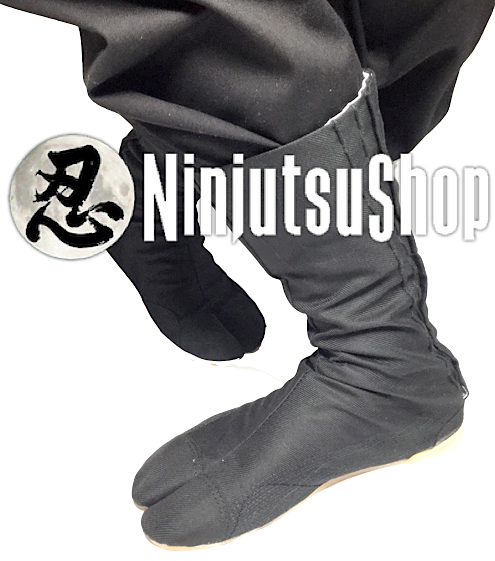
The History of the Jikatabi: Origins, Evolution, and Artisan Craftsmanship in Japan
- On 16/04/2025
- In Jikatabi
- 0 comments
Jikatabi, the traditional Japanese split-toe footwear, embodies the harmony of grounded movement, natural posture, and ancestral craftsmanship. Discover its fascinating history — from spiritual roots to its role in modern-day Ninjutsu practice.
The History of the Jikatabi: Origins, Evolution, and Artisan Craftsmanship in Japan
Jikatabi (地下足袋) are more than footwear — they are a cultural footprint deeply rooted in Japanese history. Derived from the ancient tabi (足袋), they represent functionality, grounding, and the discreet elegance of Japanese tradition. In this article, we explore their origins, evolution, and their significance in traditional Ninjutsu, especially in the Togakure Ryū lineage.
1. Origins of the Jikatabi: From Indoor Tabi to Outdoor Soles
Tabi are soft, split-toe shoes that date back to the Heian period (794–1185). Traditionally made from linen or cotton, they were worn indoors by aristocrats, samurai, and monks with zōri sandals.
The word jikatabi means “tabi for the ground.” In the 1920s, Shojiro Ishibashi, founder of Bridgestone, added a rubber sole to traditional tabi, creating a versatile, durable shoe suited for outdoor work and movement.
2. A Shoe Worn Across All Layers of Japanese Society
By the 1930s, jikatabi became popular in both rural and urban Japan:
- Construction workers: appreciated the grip and lightness on scaffolding.
- Farmers: ideal for muddy rice fields and uneven terrain.
- Martial artists: valued for posture, balance, and silent movement.
In rural areas, it was said: “A man who wears his jikatabi properly cannot lie to the earth.”
3. Jikatabi in Ninjutsu: Silence, Balance, and Awareness
In Togakure Ryū Ninpō, jikatabi are not just shoes — they are tools for discipline and awareness. Practitioners use them for Shinobi-ashi (忍び足) — silent stepping — as well as grounding and breathing practices.
Benefits for ninjutsu practice:
- Improves natural balance and posture
- Reinforces the connection between body and earth
- Sharpens proprioception and movement control
- Allows for stealth in natural and urban environments
4. Handcrafted in Japan: The Art of Jikatabi
Authentic jikatabi are still handcrafted in Kurume, a city known for its traditional footwear. Here are the main steps in the process:
- Cutting heavy-duty fabric (canvas or cotton)
- Sewing the split-toe shape
- Reinforcing the inner lining
- Attaching the rubber sole
- Adding metal hooks (kohaze 鉤) for a snug fit
Top Japanese brands include:
- Marugo – Comfort, durability, modern lines (Hitoe, Ninja Sport, etc.)
- Soukaido – Traditional designs and full handmade techniques
- Kineya – Custom-made jikatabi for Noh theater and dance
5. Why Wear Jikatabi Today?
Jikatabi aren’t just for martial arts — many people wear them for health, posture, and minimal lifestyle benefits:
- Supports a natural walking posture
- Improves balance and mobility
- Reduces tension in the back and feet
- Breathable and lightweight for summer or indoor use
They are also aligned with values of eco-consciousness and simplicity.
6. Where to Buy Authentic Japanese Jikatabi
Beware of mass-produced imitations. Choose reputable shops working directly with Japanese craftsmen:
- KimonoShop.fr – Traditional Japanese wear & footwear
- NinjutsuShop.com – Ninjutsu gear & jikatabi
- BujindoShop.com – Rare martial arts items
7. Conclusion: Walk the Path with Intention
Jikatabi are more than shoes — they are a way to reconnect with the ground, your breath, and the tradition of mindful movement. Whether you're a martial artist or a minimalist walker, they offer both utility and spirit.
Walk with respect. Walk with presence. Walk with jikatabi.
Written by Jérôme Pailliette – Togakure Ryū Ninpō Instructor, Kyoto | ninjutsukyoto.com
Add a comment


